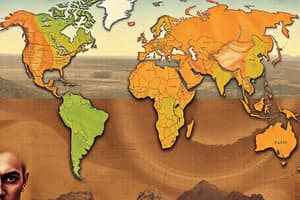Podcast
Questions and Answers
What geological feature is primarily formed at convergent boundaries when two continental plates collide?
What geological feature is primarily formed at convergent boundaries when two continental plates collide?
- Mid-ocean ridges
- Volcanoes
- Ocean trenches
- Mountain ranges (correct)
What process occurs at divergent boundaries as tectonic plates move apart?
What process occurs at divergent boundaries as tectonic plates move apart?
- Formation of volcanoes
- Destruction of old crust
- Magma rising to create new crust (correct)
- Creation of ocean trenches
Which type of boundary is associated with the occurrence of earthquakes due to plates sliding against each other?
Which type of boundary is associated with the occurrence of earthquakes due to plates sliding against each other?
- Convergent boundary
- Divergent boundary
- Transform boundary (correct)
- Subduction zone
What is the primary effect of subduction at an oceanic + continental convergent boundary?
What is the primary effect of subduction at an oceanic + continental convergent boundary?
Which of the following statements about tectonic plates is true?
Which of the following statements about tectonic plates is true?
What is the primary cause of tectonic plate movements?
What is the primary cause of tectonic plate movements?
What evidence did Alfred Wegener use to support his theory of continental drift?
What evidence did Alfred Wegener use to support his theory of continental drift?
Which layer of Earth is primarily responsible for generating its magnetic field?
Which layer of Earth is primarily responsible for generating its magnetic field?
What process occurs when tectonic plates collide?
What process occurs when tectonic plates collide?
Which statement accurately describes the crust of the Earth?
Which statement accurately describes the crust of the Earth?
Which theory transformed our understanding of Earth's geological activity in the 1960s?
Which theory transformed our understanding of Earth's geological activity in the 1960s?
What does the acronym C.R.A.P. stand for in the context of evidence supporting continental drift?
What does the acronym C.R.A.P. stand for in the context of evidence supporting continental drift?
Why is the mantle described as the thickest layer of Earth?
Why is the mantle described as the thickest layer of Earth?
Study Notes
Earth's Internal Structure
- Crust: Outermost solid layer of the Earth, divided into oceanic (denser) and continental (thicker) crust.
- Mantle: Beneath the crust, the thickest layer composed of semi-solid rock (magma) that drives plate tectonics through slow movement.
- Outer Core: Liquid layer mainly made of iron and nickel, responsible for generating Earth's magnetic field via its movements.
- Inner Core: Solid layer primarily composed of iron and nickel, with extremely high temperatures comparable to the sun's surface.
Plate Tectonics Theory
- Explains the creation of major landforms through Earth's subterranean movements, emerging in the 1960s.
- Alfred Wegener: Proposed the theory of continental drift, suggesting continents were once a single landmass called Pangaea and have since drifted apart.
Evidence Supporting Continental Drift
- Fit of the Continents: Continent shapes, notably South America and Africa, resemble interlocking puzzle pieces.
- Fossil Evidence: Identical fossils found on now-separated continents, indicating previous connection.
- Rock Formations and Mountain Ranges: Matching geological features across continents support the drift theory.
- Climate Evidence: Signs of glaciation in currently warm regions (e.g., South Africa, India) suggest these areas were once closer to the poles.
C.R.A.P. Acronym
- C: Climate evidence indicates past glacial activity in warm areas.
- R: Rock formations provide matching geological structures on different continents.
- A: Alignment of fossils shows same species present in widely separated regions.
- P: Puzzle fit demonstrates how continents can align like a jigsaw.
Tectonic Plate Interactions
- Most geologic activity occurs at plate boundaries, with three main types of tectonic interactions:
- Convergent Boundaries*: Plates come together.
- Continental + Continental = Formation of mountain ranges.
- Oceanic + Continental = Formation of volcanoes and ocean trenches.
- Divergent Boundaries*: Plates move apart.
- Magma rises from below, creates new crust, and causes ocean floor spreading.
- Transform Boundaries*: Plates slide against one another.
- Primarily associated with earthquake activity.
Geologic Activity Statistics
- 75% of Earth's volcanoes and 90% of Earth's earthquakes are due to tectonic plate movement.
- Subduction zones are locations where denser plates slide beneath less-dense plates, leading to natural phenomena such as oceanic volcano eruptions.
Summary of Forces
- Subduction destroys old crust while seafloor spreading creates new crust, balancing the Earth's shape and diameter.
Studying That Suits You
Use AI to generate personalized quizzes and flashcards to suit your learning preferences.
Description
Explore the fascinating concepts of tectonic plates and their impact on the Earth's physical environment. This quiz covers the formation of major landforms, including mountains, volcanoes, and earthquakes, based on the scientific theories established in the 1960s. Test your knowledge on the Earth's crust and mantle layers.




